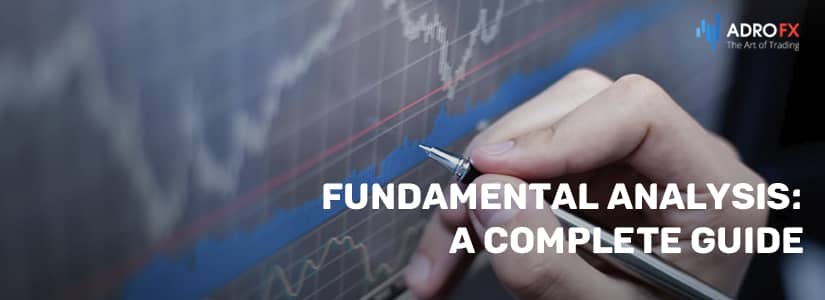Fundamental Analysis: A Complete Guide

Each trader wants to know which way the price will go. However, to get the closest to an answer to this question, it is necessary not only to watch the chart on the trading platform but also constantly keep track of what is happening in the world.
A key referendum, presidential comments, or release of negative statistics about the country can dramatically affect the national currency rate. You must have heard such phrases: "The dollar fell on the news... The euro jumped against the franc because of the news...".
The prolonged rainy season in America may damage the cotton crop: the volume of available stock may be lower than expected. This is most likely to push prices up.
News and event analysis are important factors that should be inextricably linked to trading, and their regular study and use in trading are called fundamental analysis.
What is Fundamental Analysis
Fundamental analysis is a fair assessment of the value of a stock based on the financial and economic performance of a company's health, as well as the current political environment and the reality of the market that may affect the industry in which the company operates.
This analysis is the mirror image of technical analysis, in which investors rely on price movements. They believe that the price already takes into account everything that can affect it: market sentiment, analysts' forecasts, news background, business prospects, and success. Therefore, it is not necessary to pay attention to economic factors.
Fundamentalists, first of all, look at financial statements by which they judge how well or poorly a company is performing. They also look at statistics by industry and country, seasonal factors, and the entire market.
The main goal of fundamental analysis for large investors is to choose companies that will steadily produce yields in the future. Such companies are chosen not only for investments but also for mergers or acquisitions. For example, when several retail chains merge into one to increase the turnover.
Fundamental analysis is also carried out by the management of the company to develop a financial policy. They want to understand how to increase interest in the company or how a share buyback or additional issuance will affect the market.
How Fundamental Factors Influence the Market

Many factors influence the value of stocks and the market capitalization of an issuer: for example, inflation, the key rate, employment, and industrial output. Any economic factor that reduces supply or increases demand will cause prices to rise. Conversely, any factor that increases supply or decreases demand leads to higher stocks and lower prices.
For example, the coronavirus in China led to an increase in demand for medical masks - they went up in price. The stock price of medical companies that make the masks also went up.
At the same time, the number of Chinese tourist groups around the world has dropped to zero, so travel agencies are suffering losses.
Fundamental factors affect markets in different ways. As a rule, some companies win, and others lose.
Fundamental Analysis Methods
Each investor can carry out the fundamental analysis in their way. But there are classical methods that are used more often.
Comparison method. The company is compared to its peers in the industry. The main thing is that the reference company must have a fair value of shares. This method is used when studying financial multiples.
Seasonality. Stock market prices rise and fall because of the cyclical nature of production, weather, and social processes. For example, stock prices often rise in December and January because consumer spending increases, companies pay suppliers, and the tax period closes. Financial performance in various industries improves.
There is even an omen in the U.S. market: If small-company stocks rise faster than big-company stocks in January, analysts think it will be a good year. This phenomenon has been called the "January effect." Steven B. Achelis in his book, Technical Analysis From A to Z, wrote that from 1950 to 1993, the January effect was confirmed 38 times out of 44, that is, 86% of the time.
Deduction and induction. In the inductive method, an investor relies on past data about a company, analyzes individual facts, and finds correlations between different company performances. With the inductive method, an investor moves from the particular to the general, i.e. individual characteristics of a company can be transferred to the entire industry. For instance, the P/E multiple of the largest oil companies is 5-6, which can be considered the average for the oil and gas industry.
In deduction, the investor moves from the general to the particular, i.e. it can extend all the characteristics of the industry to specific companies. Sometimes some new scientific ideas are put forward as a general judgment. For example, new technologies for extracting minerals from shale formations have reduced the value of oil and gas because more of them are being extracted. Share prices of companies in the oil and gas sector have also gone down.
The method of correlation is to measure the dependence of objects on each other. When one changes, so does the other.
The correlation coefficient can be from 1 to -1. When the correlation is close to 1, the stock prices of the correlated companies move in one direction. If the correlation is close to -1, the stock prices of the correlated companies move in different directions. If the coefficient is close to zero, then there is no relationship between the assets. The correlation coefficient can change over time.
Investors choose stocks with negative correlations to diversify their portfolios: so that prices of all stocks do not fall at the same time.
Grouping and aggregation. In this method, an investor divides a company's performance into groups based on one or more characteristics and analyzes them. One example of grouping is the company's balance sheet. The indicators are summarized in a two-sided table that shows the business assets of the company and their sources.
Structure of Fundamental Analysis
Fundamental analysis studies not only the company and the industry in which it operates but also political and economic factors. The classical structure consists of four main stages. It is usually used in its entirety by institutional investors with a large staff of analysts.
Institutional investors typically perform top-down valuations. Private investors are more likely to conduct "bottom-up" evaluations and focus more on analysis of the issuer's securities than on industry and macroeconomic analysis.
Stages of Analysis
Portfolio investors can skip the general stages and analyze only the company and its stocks.
Analysis of the overall economic situation. The investor assesses the state of the national economy, the political situation in the world and the country, and how it affects the investment. For example, in general economic analysis, an investor wants to know what happens to interest rates, consumption levels, and real income.
Individual industry analysis. At this stage, the investor evaluates the competition in the selected industry and the impact of foreign capital. You need to consider at what stage of the life cycle the industry is in because financial ratios differ at different stages of the cycle.
The analysis of the individual company is the most important stage for the private investor. Here it examines the fundamental value of the company and its financial ratios. The investor assumes that:
- the company will not cease to exist or change its business;
- the company has intrinsic value, and the current value may not coincide with the intrinsic value because the market may be inefficient;
- in the medium or long term, the market recognizes the intrinsic value of the company.
The investor assesses the fundamental value of the company by earnings, dividends, growth rate, and debt-to-equity ratio. At this stage, they calculate free cash flow, analyze return on equity, and try to predict the company's growth rate.
To analyze a company's value, an investor looks at its operations, reputation, the technology the company employs, and the quality of management. These factors affect the company's value in the eyes of all investors.
An investor compares a company's financial ratios to those of its competitors and industry averages. Special attention is usually paid to return, liquidity, and financial strength.
The investor analyzes the value of the stocks at the last stage. There are various methods of estimating their value: for example, comparative analysis cost approach, income approach, and discounted cash flow calculation. It is not necessary to calculate by hand, you can take ready-made data on analytical portals.
If the calculated price is higher than the current price, the stock has growth potential. If lower, it means that it is now overvalued and may become cheaper in the future.
Major Data Sources
Investors use open sources to analyze public companies. Information can be found on company websites, news, and analytical resources such as Investing, Nasdaq, Bloomberg, or MacroTrends.
Financial news and analysis includes the latest information on global financial markets and companies. News sites include exchange rates, stock market trading results, and analysts' forecasts. At the analytical portals, the investor can find essential facts about the companies and the economy.
Central Bank Rates. Changing interest rates is the main tool of monetary policy. Central banks target inflation with their key rate, strengthen or weaken the national currency, and influence commercial bank rates.
If the rate goes down, investors take funds out of bank deposits and look for higher returns in the stock market. If the rate rises, investors prefer stable and secure bank deposits and invest less. Central bank rates can be found on their websites and news resources.
Foreign exchange market interventions are central banks' operations with a nation's currency to change its exchange rate. When a central bank buys a national currency and sells foreign currency, the national currency rate rises, and vice versa. The euro exchange rate, for example, affects the earnings of exporting companies and the value of their stocks.
Typically, central banks use foreign exchange reserves for such operations. Information about central bank operations can also be found on their websites.
Macroeconomic indicators measure the state of a country's economy in numbers. They are also called macroeconomic indicators. The main macroeconomic indicators: are GDP, inflation rates, unemployment, and others. These data are released on a schedule, they are published by major news and analytical resources.
Economic calendar. Reference portals publish a schedule of economic events for the week ahead. In the economic calendar, events are broken down by time and country. The most important events are highlighted by shaded symbols: if all three are shaded, it means that the news is very important. It is also possible to see how indicators have changed compared to previous data.

Usually, calendars have forecasts on them. If a financial indicator is lower than the forecasted value, traders perceive it negatively. Conversely, if it is higher than forecasted, the market is growing.
In addition to economic calendars, there are investor calendars. Brokers and issuers publish them. Such calendars contain dates of closing of registers, dividend payments, and release dates of companies' reports. The most important events in the investor calendar are also highlighted.
Companies' financial and accounting reports. An investor can find financial and accounting reports, dividend policy information, a calendar of major events, and other useful information on the website of public companies. It is common for companies to make an entire "Investor Relations" section on their website to increase transparency and accessibility of information. Below you can see investor`s tab on the Tesla`s website:

Force Majeure Situations
In addition to scheduled and expected events and indicators, the market is strongly influenced by factors that cannot be predicted in advance. Such factors are called force majeure, or black swans.
Military conflicts affect financial assets in different ways. For example, a drone attack on Saudi oil facilities on the night of Sept. 14, 2019, raised oil prices by 16-19% in a single day. Saudi Arabia is the largest supplier of oil, and traders worried that exports would fall sharply.
As a rule, stocks of military-industrial complex companies rise during military conflicts.
Natural and man-made disasters. After the accident at the Fukushima-1 nuclear power plant in Japan, the Nikkei stock index fell more than 20% in three trading sessions.
Political instability. Other notable phenomena include recession announcements, post-session comments by politicians, unexpected management decisions, scandals, sanctions, confrontations, results of negotiations between leaders, discussions in economic forums, and sudden government participation in the form of stakes in private companies: a possible method to save the economy which should be considered when conducting fundamental analysis of stocks in crisis and post-crisis times. Elections and the risk of a change of government course are also perceived as political instability, which can destabilize both the currency and the stock markets of the country until the outlook becomes clearer.

Another example. Former U.S. President Donald Trump used Twitter extensively. His tweets influenced the prices of stock and commodity markets. For example, on February 25, 2020, he wrote that the coronavirus was under control in the United States. U.S. stock indices reacted to such a statement by falling.
An Example of Using Fundamental Analysis
Classical fundamental analysis is complicated and time-consuming for a retail investor. For this purpose, it is necessary to study reports of the company, and compare its performance with the industry average and with the performance of competing companies. It is also necessary to take into account economic and political risks.
The fundamental analysis seems complicated because there are many steps and it is not clear how to do it in real life. The fundamental analysis must choose reliable and beneficial stocks, so it can be simplified without loss of quality. For example, first, determine the style of investing.
Growth investing. Investors look for companies with consistently high growth in earnings over several years. The P/E ratio can be quite high compared to other companies in the industry. The P/E ratio shows the ratio of a company's present value to its net income and helps estimate how long it will take a company to pay for itself.
Stock prices are very volatile, meaning that they can change by several percent in a single trading day. EPS grow 15-20% a year along with the stock price. EPS is net income per common share. The market share of such companies grows because of aggressive management, new technology, or a strong brand.
Growth companies may not have returns. Investors buy such stocks because they believe the company is undervalued and that asset values will rise strongly in the future.
Value investing. Investors look for undervalued companies with low P/E, P/S, and P/BV multiples. P/S is the ratio of capitalization to revenue, good if the ratio is less than 2. P/BV is the ratio of the company's value to its capital, and it is good if the ratio is less than 1. The stock prices of such companies may increase significantly in the future, but right now, the returns may be small.
These may be large companies with high earnings. The growth rate of P/E multiples and the P/E itself of undervalued companies should be below the industry and market average.
Fundamental investing. Investors look for companies with undervalued assets, i.e. they focus on investing in the physical assets of the company. Such companies have few liabilities and lots of cash on their balance sheets. P/E and P/BV ratios are low. Stocks are low volatility, yields are also not very high.
Income investing. Investors choose large companies with sustainable and high dividends. Investors look at historical dividend payout trends.
The stocks themselves are low-volatility, their share price usually does not rise sharply, but dividends are high and rising. Dividend yields can be found on an investor's calendar - they are published by brokers and analytical portals.
Fundamental Analysis of the Forex Market
As a rule, it is used by currency speculators, who earn on changes in currency rates. Currency pair prices are highly dependent on news and economic statistics.
News can be unexpected and predictable. Predictable news is published at news portals according to a schedule. For example, the first Friday of each month is the U.S. Non-Farm Payrolls report. The better the numbers, the steadier the dollar is against other currencies.
Political factors such as presidential elections, wars, and revolutions. For example, the British pound fell more than 8% against the U.S. dollar in one day after the decision to leave the U.K. from the European Union on June 23, 2016: traders and investors feared an economic downturn.

Economic factors come in as expected and accidental. Expected ones come out on schedule: economic growth, inflation, and unemployment data. Random ones come out unexpectedly.
When Fundamental Analysis Is Ineffective
Fundamental analysis cannot account for all factors. For example, a drought can affect crops and the share price of agricultural companies. Not all important facts about the economy and industry are known to the retail investor, and those that are known can be interpreted in different ways.
Criticism of fundamental analysis is related to its subjectivity and the fact that the analysis uses information that is already known to all investors. If the information is known to all, there is hardly any advantage to be gained from it.
In addition, there is no guarantee that an undervalued stock will be fairly valued by the market in the future. Companies may embellish their statements, which can cause an investor to misjudge the fair value of the stock. And non-public companies do not provide investors with reports necessary for analysis at all.
The process of fundamental analysis itself is very laborious and long. It is designed for a long investment horizon – it is difficult to use fundamental analysis for short-term or intraday trading.

About AdroFx
Established in 2018, AdroFx is known for its high technology and its ability to deliver high-quality brokerage services in more than 200 countries around the world. AdroFx makes every effort to keep its customers satisfied and to meet all the trading needs of any trader. With the five types of trading accounts, we have all it takes to fit any traders` needs and styles. The company provides access to 115+ trading instruments, including currencies, metals, stocks, and cryptocurrencies, which make it possible to make the most out of trading on the financial markets. Considering all the above, AdroFx is the perfect variant for anyone who doesn't settle for less than the best.









